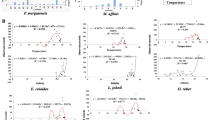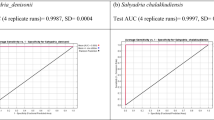Abstract
Most fish and shrimps have valuable ecological and commercial benefits. The difficulties of the collection of distribution records and volatile nature these marine organisms have limited their monitoring and conserving. MaxEnt modeling technique is ideal option for modeling distribution and habitat preference of different marine organisms. In this study, the present distribution of commercial fish and shrimps including orange-spotted grouper John’s snapper, tigertooth croaker, banana and Jinga shrimps was predicted using MaxEnt and a set of environmental layers. Distribution modeling findings showed that this technique reflects well the actual distribution of species. Environmental predictors including iron, calcite, temperature, primary productivity and depth were the most important environmental factors determining the distribution of species. Finding of habitat preferences indicated that the recent habitats of the species have suitable environmental conditions for the species. The Persian Gulf, the Sea of Oman, the North Arabian Sea and Australia coasts of the South Pacific were predicted as the most suitable habitats for species. The finding of this study provided basic data to identify distribution areas and habitat preferences of commercial fish and shrimps for their recent management plans and conservation development.
چکیده
اکثر ماهیان و میگوها،سودمندی¬های تجاری و اکولوژیکی ارزشمندی دارند. مشکلات جمع¬آوری رکوردهای پراکنش، و طبیعت متحرک این موجودات دریایی، پایش و حفاظت آن¬ها را محدود کرده است. تکنیک مدل¬سازی MaxEnt، انتخابی ایده¬آل جهت مدل¬سازی پراکنش و اولویت¬های زیستگاهی موجودات دریایی متنوع، می¬باشد. در این مطالعه، پراکنش اخیر ماهیان و میگو¬های تجاری شامل هامور معمولی، سرخو معمولی، شوریده معمولی، میگو موزی و میگو سرتیز، با استفاده از MaxEnt و مجموعه¬ای از لایه¬های محیطی، مدل¬سازی شد. یافته¬های مدل¬سازی پراکنش، نشان داد که این تکنیک به¬خوبی انعکاس¬دهنده پراکنش واقعی گونه¬ها می¬باشد. پیش¬بینی¬کننده¬های محیطی شامل آهن، کلسیت، دما، تولید اولیه و عمق، مهم¬ترین عوامل محیطی تعیین¬دهنده پراکنش گونه¬ها، بودند. یافته¬های اولویت زیستگاهی نشان داد که زیستگاه¬های اخیر گونه¬ها، شرایط محیطی مناسب برای آن¬ها را دارند. خلیج¬فارس، دریای عمان، شمال دریای عرب و سواحل استرالیا در جنوب اقیانوس آرام، به¬عنوان مناسب¬ترین زیستگاه¬ها برای گونه¬ها، پیش¬بینی شد. یافته¬های این مطالعه، داده¬های پایه به¬منظور تشخیص نواحی پراکنش و اولویت-های زیستگاهی ماهیان و میگوهای تجاری، جهت برنامه¬های اخیر مدیریتی و پیشرفت¬های حفاظتی، فراهم نمود.


Similar content being viewed by others
Data Availability
The datasets used and/or analyzed during the current study are available from the corresponding author on reasonable request.
References
Assis J, Tyberghein L, Bosch S, Verbruggen H, Serrão EA, De Clerck O (2018) Bio-ORACLE v2.0: extending marine data layers for bioclimatic modelling. Glob Ecol Biogeogr 27:277–284. https://doi.org/10.1111/geb.12693
Basher Z, Costello MJ (2016) The past, present and future distribution of a deep-sea shrimp in the Southern Ocean. PeerJ 4:e1713. https://doi.org/10.7717/peerj.1713
Basher Z, Bowden DA, Costello MJ (2018) Global marine environment datasets (GMED). World wide web electronic publication. Version 2.0 (rev.02.2018). Accessed at http://gmed.auckland.ac.nz on <access DATE>. [WWW document]. Accessed 12 Oct 2021
Cheung WWL, Lam VWY, Sarmiento JL, Kearney K, Watson R, Pauly D (2009) Projecting global marine biodiversity impacts under climate change scenarios. Fish Fish 10:235–251. https://doi.org/10.1111/j.1467-2979.2008.00315.x
Cheung WWL, Lam VWY, Sarimento JL, Kearney K, Watson REG, Zeller D, Pauly D (2010) Large-scale redistribution of maximum fisheries catch potential in the global ocean under climate change. Glob Chang Biol 16:24–35. https://doi.org/10.1111/j.1365-2486.2009.01995.x
Dambach J, Thatje S, Rödder D, Basher Z, Raupach MJ (2012) Effects of late-Cenozoic glaciation on habitat availability in Antarctic benthic shrimps (Crustacea: Decapoda: Caridea). PLoS One 7:e46283
Davies AJ, Guinotte JM (2011) Global habitat suitability for framework-forming cold-water corals. PLoS One 6:e18483. https://doi.org/10.1371/journal.pone.0018483
Drewnik A, Węsławski JM, Włodarska-Kowalczuk M (2017) Benthic Crustacea and Mollusca distribution in Arctic fjord – case study of patterns in Hornsund, Svalbard. Oceanologia 59:565–575. https://doi.org/10.1016/j.oceano.2017.01.005
Farashi A, Shariati M (2017) Biodiversity hotspots and conservation gaps in Iran. J Nat Conserv 39:37–57. https://doi.org/10.1016/j.jnc.2017.06.003
Gaston KJ, Fuller RA (2009) The sizes of species’ geographic ranges. J Appl Ecol 46:1–9. https://doi.org/10.1111/j.1365-2664.2008.01596.x
Guisan A, Tingley R, Baumgartner JB, Naujokaitis-Lewis I, Sutcliffe PR, Tulloch AIT, Regan TJ, Brotons L, McDonald-Madden E, Mantyka-Pringle C, Martin TG, Rhodes JR, Maggini R, Setterfield SA, Elith J, Schwartz MW, Wintle BA, Broennimann O, Austin M et al (2013) Predicting species distributions for conservation decisions. Ecol Lett 16:1424–1435. https://doi.org/10.1111/ele.12189
Hanski I (2011) Habitat loss, the dynamics of biodiversity, and a perspective on conservation. Ambio 40:248–255. https://doi.org/10.1007/s13280-011-0147-3
Harris G, Jenkins C, Pimm S (2005) Refining biodiversity conservation priorities. Conserv Biol 19:1957–1968. https://doi.org/10.1111/j.1523-1739.2005.00307.x
Himes-Cornell A, Pendleton L, Atiyah P (2018) Valuing ecosystem services from blue forests: a systematic review of the valuation of salt marshes, sea grass beds and mangrove forests. Ecosyst Serv 30:36–48. https://doi.org/10.1016/j.ecoser.2018.01.006
Hutton T, Pascoe S, Deng RA, Punt AE, Zhou S (2022) Effects of re-specifying the northern prawn fishery bioeconomic model to include banana prawns. Fish Res 247:106190. https://doi.org/10.1016/j.fishres.2021.106190
Jiménez-Valverde A, Lobo JM (2007) Threshold criteria for conversion of probability of species presence to either–or presence–absence. Acta Oecol 31:361–369. https://doi.org/10.1016/j.actao.2007.02.001
Jones MC, Cheung WWL (2015) Multi-model ensemble projections of climate change effects on global marine biodiversity. ICES J Mar Sci 72:741–752. https://doi.org/10.1093/icesjms/fsu172
Khodanazary A (2019) Freshness assessment of shrimp Metapenaeus affinis by quality index method and estimation of its shelf life. Int J Food Prop. https://doi.org/10.1080/10942912.2019.1580719
Kuhn T, Cunze S, Kochmann J, Klimpel S (2016) Environmental variables and definitive host distribution: a habitat suitability modelling for endohelminth parasites in the marine realm. Sci Rep 6:30246. https://doi.org/10.1038/srep30246
Lassalle G, Crouzet P, Rochard E (2009) Modelling the current distribution of European diadromous fishes: an approach integrating regional anthropogenic pressures. Freshw Biol 54:587–606
Lobo JM, Jiménez-Valverde A, Real R (2008) AUC: a misleading measure of the performance of predictive distribution models. Glob Ecol Biogeogr 17:145–151. https://doi.org/10.1111/j.1466-8238.2007.00358.x
Margules CR, Pressey RL (2000) Systematic conservation planning. Nature 405:243–253. https://doi.org/10.1038/35012251
Meißner K, Fiorentino D, Schnurr S, Martinez Arbizu P, Huettmann F, Holst S, Brix S, Svavarsson J (2014) Distribution of benthic marine invertebrates at northern latitudes ― An evaluation applying multi-algorithm species distribution models. J Sea Res 85:241–254. https://doi.org/10.1016/j.seares.2013.05.007
Mittermeier R, Turner W, Larsen F, Brooks T, Gascon C (2011) Global biodiversity conservation: the critical role of hotspots. In: Biodiversity Hotspots, pp 3–22. https://doi.org/10.1007/978-3-642-20992-5_1
Momenzadeh Z, Khodanazary A, Ghanemi K (2017) Effect of different cooking methods on vitamins, minerals and nutritional quality indices of orange-spotted grouper (Epinephelus coioides). J Food Meas Charact 11:434–441. https://doi.org/10.1007/s11694-016-9411-3
Olden JD, Jackson DA (2002) A comparison of statistical approaches for modelling fish species distributions. Freshw Biol 47:1976–1995. https://doi.org/10.1046/j.1365-2427.2002.00945.x
Pereira HM, Leadley PW, Proença V, Alkemade R, Scharlemann JPW, Fernandez-Manjarrés JF, Araújo MB, Balvanera P, Biggs R, Cheung WWL, Chini L, Cooper HD, Gilman EL, Guénette S, Hurtt GC, Huntington HP, Mace GM, Oberdorff T, Revenga C et al (2010) Scenarios for global biodiversity in the 21st century. Science 330:1496–1501. https://doi.org/10.1126/science.1196624
Peterson A, Soberón J, Pearson R, Anderson R, Martínez-Meyer E, Nakamura M, Araújo M (2011) Ecological niches and geographic distributions. Monogr Popul Biol. https://doi.org/10.1515/9781400840670
Phillips SJ, Dudík M (2008) Modeling of species distributions with Maxent: new extensions and a comprehensive evaluation. Ecography (Cop) 31:161–175. https://doi.org/10.1111/j.0906-7590.2008.5203.x
Phillips SJ, Anderson RP, Schapire RE (2006) Maximum entropy modeling of species geographic distributions. Ecol Model 190:231–259. https://doi.org/10.1016/j.ecolmodel.2005.03.026
Phillips SJ, Anderson RP, Dudík M, Schapire RE, Blair ME (2017) Opening the black box: an open-source release of Maxent. Ecography (Cop) 40:887–893. https://doi.org/10.1111/ecog.03049
Pickens B, Carroll R, Schirripa MJ, Francesca F, Friedland KD, Christopher TJ (2021) A systematic review of spatial habitat associations and modeling of marine fish distribution: a guide to predictors, methods, and knowledge gaps. PLoS One 5:1–21
Pineda E, Lobo JM (2009) Assessing the accuracy of species distribution models to predict amphibian species richness patterns. J Anim Ecol 78:182–190. https://doi.org/10.1111/j.1365-2656.2008.01471.x
Putra MIH, Mustika PLK (2021) Maximum entropy model: estimating the relative suitability of cetacean habitat in the northern Savu Sea, Indonesia. Mar Mammal Sci 37:6–28. https://doi.org/10.1111/mms.12719
Renuka V, Zynudheen AA, Panda SK, Ravishankar CNR (2016) Nutritional evaluation of processing discards from tiger tooth croaker, Otolithes ruber. Food Sci Biotechnol 25:1251–1257. https://doi.org/10.1007/s10068-016-0198-0
Rhoden CM, Peterman WE, Taylor CA (2017) Maxent-directed field surveys identify new populations of narrowly endemic habitat specialists. PeerJ 5:e3632. https://doi.org/10.7717/peerj.3632
Robinson NM, Nelson WA, Costello MJ, Sutherland JE, Lundquist CJ (2017) A systematic review of marine-based species distribution models (SDMs) with recommendations for best practice. Front Mar Sci 4:421. https://doi.org/10.3389/fmars.2017.00421
Saeedi H, Basher Z, Costello MJ (2016) Modelling present and future global distributions of razor clams (Bivalvia: Solenidae). Helgol Mar Res 70:23. https://doi.org/10.1186/s10152-016-0477-4
Schmiing M, Afonso P, Tempera F, Santos RS (2013) Predictive habitat modelling of reef fishes with contrasting trophic ecologies. Mar Ecol Prog Ser 474:201–216
Serpetti N, Baudron AR, Burrows MT, Payne BL, Helaouët P, Fernandes PG, Heymans JJ (2017) Impact of ocean warming on sustainable fisheries management informs the ecosystem approach to fisheries. Sci Rep 7:13438. https://doi.org/10.1038/s41598-017-13220-7
Sharifian S, Zakipour E, Mortazavi M, Arshadi A (2011) Quality assessment of Tiger tooth croaker (Otolithes ruber) during ice storage. Int J Food Prop 14:309–318. https://doi.org/10.1080/10942910903177822
Sharifian S, Kamrani E, Saeedi H (2020) Global biodiversity and biogeography of mangrove crabs: temperature, the key driver of latitudinal gradients of species richness. J Therm Biol 92:102692. https://doi.org/10.1016/j.jtherbio.2020.102692
Sharifian S, Kamrani E, Saeedi H (2021a) Global future distributions of mangrove crabs in response to climate change. Wetlands 41:99. https://doi.org/10.1007/s13157-021-01503-9
Sharifian S, Kamrani E, Saeedi H (2021b) Insights toward the future potential distribution of mangrove crabs in the Persian Gulf and the sea of Oman. J Zool Syst Evol Res 1–12. https://doi.org/10.1111/jzs.12532
Sheridan P, Hays C (2003) Are mangroves nursery habitat for transient fishes and decapods? Wetlands 23:449–458. https://doi.org/10.1672/19-20
Snelgrove P, Berghe EV, Miloslavich P, Archambault P, Bailly N, Brandt A (2016) Global patterns in marine biodiversity, in: first global marine assessment. United Nations, p. 37pp
Squalli J (2020) Evaluating the potential economic, environmental, and social benefits of orange-spotted grouper aquaculture in the United Arab Emirates. Mar Policy 118:103998. https://doi.org/10.1016/j.marpol.2020.103998
Tyberghein L, Verbruggen H, Pauly K, Troupin C, Mineur F, De Clerck O (2012) Bio-ORACLE: a global environmental dataset for marine species distribution modelling. Glob Ecol Biogeogr 21:272–281. https://doi.org/10.1111/j.1466-8238.2011.00656.x
Urcádiz-Cázares FJ, Cruz-Escalona VH, Peterson MS, Marín-Enriquez E, González-Acosta AF, Martínez-Flores G, Hernández-Carmona GH, Aguilar-Medrano R, Del Pino-Machado A, Ortega-Rubio A (2021) Ecological niche modelling of endemic fish within La Paz Bay: implications for conservation. J Nat Conserv 60:125981. https://doi.org/10.1016/j.jnc.2021.125981
Yu C, Ngoprasert D, Savini T, Round PD, Gale GA (2020) Distribution modelling of the endangered spotted greenshank (Tringa guttifer) in a key area within its winter range. Glob Ecol Conserv 22:e00975. https://doi.org/10.1016/j.gecco.2020.e00975
zu Ermgassen PSE, Mukherjee N, Worthington TA, Acosta A, Rocha Araujo AR d, Beitl CM, Castellanos-Galindo GA, Cunha-Lignon M, Dahdouh-Guebas F, Diele K, Parrett CL, Dwyer PG, Gair JR, Johnson AF, Kuguru B, Savio Lobo A, Loneragan NR, Longley-Wood K, Mendonça JT et al (2020) Fishers who rely on mangroves: modelling and mapping the global intensity of mangrove-associated fisheries. Estuar Coast Shelf Sci 247:106975. https://doi.org/10.1016/j.ecss.2020.106975
Acknowledgements
We thank the National Elite Foundation for financial support of this project. We would also like to thank the experts of department Ecology in Persian Gulf and Oman Sea Ecological Research Institute for their assistance in sampling and data collection.
Author information
Authors and Affiliations
Contributions
Sana Sharifian: Methodology, Data analysis, Writing and Editing paper. Mohammad Seddiq Mortazavi and Seyedeh Laili Mohebbi-Nozar: Conceptualization, and Methodology. All authors read and approved the final manuscript.
Corresponding author
Ethics declarations
Ethical Approval
All studies were conducted in accordance with principles for international, national, and/or institutional guidelines for the care and use of animals. This article does not contain any studies involving human participants performed by any of the authors. The manuscript in part or in full has not been submitted or published anywhere.
Consent to Participate
Informed consent was obtained from all individual participants included in the study.
Consent for Publication
The authors affirm that human research participants provided informed consent for publication of the aggregate data produced in the study.
Conflict of Interest
The authors declare that they have no conflict of interest.
Additional information
Publisher’s Note
Springer Nature remains neutral with regard to jurisdictional claims in published maps and institutional affiliations.
Rights and permissions
About this article
Cite this article
Sharifian, S., Mortazavi, M.S. & Mohebbi-Nozar, S.L. Modeling Present Distribution Commercial Fish and Shrimps Using MaxEnt. Wetlands 42, 39 (2022). https://doi.org/10.1007/s13157-022-01554-6
Received:
Accepted:
Published:
DOI: https://doi.org/10.1007/s13157-022-01554-6




